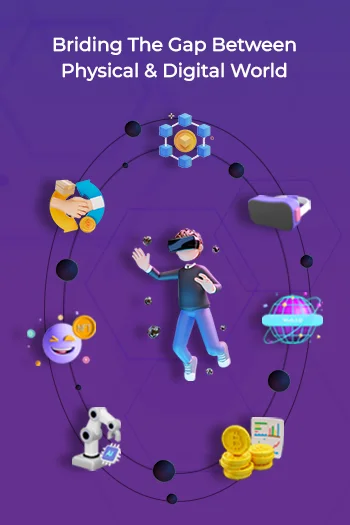By integrating stablecoins for AI automation, organizations can achieve instant settlements, eliminate intermediaries, and ensure stable value transfers across borders. Whether for digital payments, DeFi operations, or smart contract execution, AI agent development services are empowering enterprises to transition toward self-operating financial ecosystems. Together, AI agents and stablecoins are transforming finance into a dynamic, data-driven infrastructure that runs autonomously — securely, efficiently, and intelligently.
What Are Autonomous Blockchain Payments?
How Do Autonomous Blockchain Payments Work?
- Data Collection and Decision Intelligence (AI Layer)
- It gathers inputs from multiple sources — such as market feeds, IoT devices, APIs, and user-defined rules.
- The agent processes this data using machine learning models or predictive analytics to determine when a payment or transaction should be triggered.
- For example, in a decentralized marketplace, an AI agent may detect inventory depletion and automatically initiate a restock payment in stablecoins.
- Smart Contract Trigger and Validation (Blockchain Layer)
- Smart contracts are self-executing programs that define transaction logic and conditions (e.g., “If product delivered → release payment”).
- When the trigger condition is met, the smart contract executes autonomously.
- The blockchain validates this action, ensuring that all nodes agree the terms have been satisfied before recording the transaction.
- Stablecoin-Powered Transaction (Financial Layer)
- Stablecoins are pegged to assets like USD, EUR, or gold, making them ideal for automation and long-term contracts.
- The AI agent instructs the smart contract to transfer the required stablecoin amount to the recipient’s wallet.
- The transaction is settled on-chain instantly, with complete transparency and traceability.
- Ledger Recording and Feedback Loop
- Every transaction becomes part of a tamper-proof audit trail.
- The AI agent reviews transaction results, learning from outcomes to optimize future decisions — this forms a feedback loop that enhances system intelligence over time.
- Continuous Automation and Scalability
- Devices, applications, and smart systems communicate and transact autonomously.
- Businesses gain real-time insights and reduced operational friction.
- The system scales globally without the limitations of legacy banking frameworks.
| Step | Process | Technology Involved | Outcome |
| 1 | Data Collection | AI Agent, APIs, Sensors | Decision Context |
| 2 | Decision Making | Machine Learning Models | Trigger Signal |
| 3 | Smart Contract Execution | Blockchain | Automated Validation |
| 4 | Stablecoin Transfer | Crypto Ledger | Instant Settlement |
| 5 | Feedback & Optimization | Reinforcement Learning | Improved Future Accuracy |
How Do AI Agents Work in Finance?
Core Working Mechanism of AI Agents in Finance
The lifecycle of an AI agent typically follows these steps:
- Enabling Predictable AI Agent Transactions
For autonomous systems, uncertainty in transaction value can disrupt financial logic. Stablecoins for AI automation provides predictable purchasing power, ensuring that:
- Payment thresholds are met accurately.
- Portfolio rebalancing occurs without loss from crypto volatility.
- Cross-border settlements maintain value consistency.
- Facilitating Real-Time, Borderless Payments
- Transactions settle in seconds, not days.
- Cross-border payments avoid traditional banking fees and delays.
- AI agents can autonomously manage multi-currency operations while maintaining stability.
- Reducing Risk in AI-Driven Financial Systems
- Execute complex financial strategies without exposure to crypto swings.
- Automate loan repayments, payroll, and subscription services safely.
- Maintain liquidity in decentralized finance (DeFi) protocols for yield optimization.
- Smart Contract Integration with Stablecoins
- Trigger payments only when contract conditions are met.
- Ensure consistent value transfers in AI-driven escrow systems.
- Facilitate microtransactions between machines or applications in real-time.
- Supporting Machine-to-Machine (M2M) Transactions
- An electric vehicle pays for charging automatically.
- A drone pays for airspace usage or energy credits autonomously
- Industrial IoT sensors transact for bandwidth or storage without human intervention.
- Enhancing Compliance and Auditability
- AI agents can log every transaction transparently on-chain.
- Pegged value makes accounting predictable and audit-friendly.
- They support KYC/AML compliance without the volatility-related reporting challenges seen in other cryptocurrencies.
Stablecoin Function | Impact on AI Agents & Autonomous Finance |
Price Stability | Predictable, reliable automated payments |
Programmable Money | Integrated with smart contracts for autonomous execution |
Fast, Borderless Settlements | Supports real-time cross-border operations |
Risk Reduction | Minimizes volatility-related financial risk |
Microtransaction Capability | Enables M2M payments and IoT automation |
Compliance & Auditability | Simplifies accounting and regulatory reporting |
- The Strategic Role of Stablecoins
In essence, stablecoins are the fuel that powers autonomous blockchain finance. They enable AI agents to operate autonomously, make intelligent financial decisions, and execute transactions with precision. By combining stablecoins for AI automation with AI agent development services, enterprises can create a self-operating, reliable, and global financial ecosystem — one that is capable of handling high-frequency payments, multi-chain interactions, and smart contract-driven workflows.
How Do AI Agents and Stablecoins Work Together?
Stablecoins act as a reliable medium of exchange for AI agents. Their value stability allows AI agents to:
- Execute precise financial actions without exposure to crypto volatility.
- Perform high-frequency payments and settlements confidently.
- Automate cross-border transfers without worrying about fluctuating exchange rates.
AI agents continuously monitor multiple data sources — such as market conditions, liquidity status, and contract triggers. Based on this information, they decide:
- When to release funds
- How much to send
- Which route or blockchain network to use
Once the decision is made, the AI agent instructs a smart contract to execute the transaction using stablecoins.
Use Case | How AI Agents + Stablecoins Work | Benefit |
Payroll Automation | AI agents calculate wages and trigger stablecoin transfers | Timely, accurate payments |
Supply Chain Payments | AI monitors delivery status and triggers stablecoin release | Real-time settlements |
DeFi Lending & Borrowing | AI agents manage loan issuance and repayment in stablecoins | Reduced risk, automated interest |
IoT Microtransactions | Devices pay for energy or bandwidth using stablecoins | Autonomous M2M economy |
Treasury Management | AI reallocates stablecoin reserves across protocols | Optimized liquidity |
- 24/7 Automated Operations
AI agents ensure that financial operations never stop.
- Payments, settlements, and trades can occur around the clock, without human oversight.
- Ideal for global enterprises, cross-border e-commerce, and DeFi platforms that need uninterrupted financial activity.
- Example: An AI agent managing payroll or subscription payments can execute transactions automatically at any time, including weekends or holidays.
- Instant, Low-Cost Settlements
Autonomous blockchain payments eliminate traditional intermediaries such as banks or payment gateways.
- Transactions settle in seconds, regardless of geography.
- Low transaction fees make it feasible for micro-payments or high-frequency operations.
- Example: IoT devices, like EVs paying for charging, can complete micropayments instantly using stablecoins for AI automation, without waiting for bank approvals.
- No Intermediaries or Delays
AI agents interact directly with smart contracts and blockchain networks:
- No need for third-party verification or approval.
- Reduces processing delays, bureaucracy, and risk of error.
- Example: A supply chain platform can automatically release payments to vendors once a shipment is delivered — all without human oversight.
- Transparent and Auditable Records
All transactions are recorded immutably on the blockchain:
- AI agents maintain clear audit trails for all automated actions.
- Regulators, auditors, or stakeholders can verify records in real time.
- Example: A corporate treasury system can track every stablecoin transaction executed by AI agents, ensuring full compliance and transparency.
- Global Accessibility with Stable Value Transfers
Stablecoins enable borderless transactions with predictable value:
- Payments are not affected by currency fluctuations.
- Businesses can operate seamlessly across multiple countries and blockchains.
- Example: An international freelancer platform can pay workers worldwide using AI-driven stablecoin transfers, guaranteeing exact amounts without conversion losses.
- Scalability and Flexibility
Autonomous blockchain systems scale easily for high-volume or complex transactions:
- AI agents can handle thousands of payments simultaneously.
- Microtransactions, subscription payments, and enterprise-level treasury management are automated without adding operational overhead.
- Enhanced Security and Trust
- Blockchain provides cryptographic security, protecting against fraud and tampering.
- AI agents continuously monitor transactions, detect anomalies, and enforce compliance rules.
- This combination builds a trustless, reliable financial ecosystem for enterprises and DeFi platforms.
- Ideal for Emerging Financial Use Cases
Autonomous blockchain payments are particularly beneficial for:
- Fintechs: Automating payments, loans, and digital wallets.
- DeFi Platforms: Instant, low-cost settlements with stablecoins.
- IoT-Based Payment Systems: Machine-to-machine transactions like smart vehicles, drones, or sensors paying for services autonomously.
What Industries Can Use AI Agents and Stablecoins?
- Banking & Fintech
- Use Case: AI agents automate loan approvals, risk assessment, regulatory compliance, and cross-border payments.
- Impact: Faster transactions, reduced fraud, and smarter lending decisions.
- Example: A bank can deploy AI agents to monitor customer creditworthiness and execute loan disbursements in stablecoins automatically.
- Supply Chain & Logistics
- Use Case: Real-time settlements between suppliers, distributors, and retailers.
- Impact: Eliminates payment delays, reduces disputes, and ensures transparent audit trails.
- Example: AI agents can automatically release stablecoin payments to vendors upon delivery confirmation captured by IoT sensors.
- Energy & IoT
- Use Case: Machine-to-machine (M2M) payments for energy consumption, bandwidth usage, or service subscriptions.
- Impact: Creates a self-sustaining IoT ecosystem where devices transact autonomously.
Example: A smart electric vehicle can pay for charging automatically using stablecoins via an AI agent.
- Insurance
- Use Case: Automated claim verification and payout settlements.
- Impact: Reduces processing time, fraud risk, and administrative overhead.
- Example: AI agents can analyze damage reports, validate policy coverage, and trigger instant stablecoin payouts to claimants.
- Investment Management & DeFi
- Use Case: Robo-advisory, portfolio rebalancing, yield farming, and automated lending protocols.
- Impact: Provides smarter, data-driven investment decisions and real-time liquidity management.
- Example: AI agents can move assets between stablecoins and other cryptocurrencies to optimize returns while managing risk.
- Healthcare & Pharmaceutical Industry
- Use Case: Automated billing, claims processing, and supply chain payments for medical supplies.
- Impact: Reduces errors, accelerates reimbursements, and ensures transparent financial tracking.
- Example: Hospitals using AI agents can settle supplier invoices in stablecoins immediately after medical supplies are delivered.
- Real Estate & Property Management
- Use Case: Rent collection, escrow management, and property transaction settlements.
- Impact: Faster, transparent, and secure financial flows with reduced intermediaries.
Example: AI agents can automatically release rental payments to landlords in stablecoins, triggering smart contracts when lease conditions are fulfilled.
- Retail & E-commerce
- Use Case: Instant cross-border payments to suppliers, refunds, and automated loyalty rewards.
- Impact: Improves customer experience, streamlines vendor payments, and reduces transaction costs.
- Example: AI agents can automatically convert sales revenue into stablecoins for inventory procurement globally.
How Shamla Tech Powers Autonomous Blockchain Payments with AI Agents and Stablecoins
At Shamla Tech, we build autonomous blockchain payment solutions that combine AI agents with stablecoins to deliver fast, secure, and intelligent financial operations. We build AI agents that act as digital decision-makers, analyzing data, predicting trends, and executing transactions automatically, enabling your business to operate 24/7 without human intervention.
We integrate stablecoins to ensure payments are predictable, value-stable, and suitable for cross-border, high-frequency transactions. Through encrypted smart contracts, our systems trigger payments only when conditions are met, providing full auditability and transparency.
FAQs
Add Your Heading Text Here
- Intelligent digital banks
- Self-executing corporate treasuries
- Machine-driven investment platforms
- Autonomous economic networks
- Are autonomous blockchain payments scalable for enterprises?
- Regulatory uncertainty around AI-driven transactions
- Data privacy and auditability
- Complex integration between AI systems and blockchain infrastructure
- Can AI agents replace financial intermediaries?
- What makes stablecoins ideal for AI automation?
- How can businesses adopt autonomous blockchain payments?
- Build custom AI payment agents
- Integrate blockchain and stablecoin networks
- Automate smart contract execution
- Develop secure, compliant financial workflows


